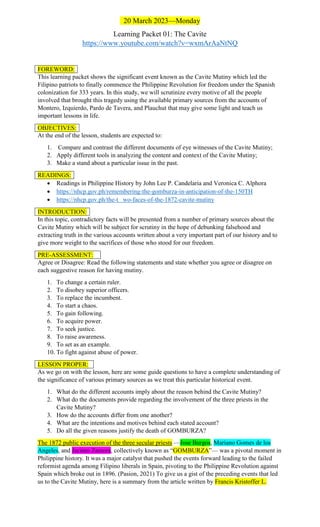The document provides an overview of a learning packet about the 1872 Cavite Mutiny in the Philippines, which was a significant event that led Filipino patriots to commence the Philippine Revolution against 333 years of Spanish colonization. The packet aims to scrutinize accounts of the mutiny from primary sources to understand motives and extract truth. It presents objectives for students to analyze and compare eyewitness documents, apply analytical tools, and take a stand on issues. The introduction notes contradictory facts will be analyzed to debunk falsehoods. The packet also includes guidelines for discussion and activities analyzing accounts to understand context, content and consequences.

![Pasion “Remembering the GOMBURZA: In Anticipation of the 150th Anniversary of their
Martyrdom in 2022.
The opening of the Suez Canal in 1869 made it easier and faster to travel from Spain to the
Philippines from approximately twenty months to thirty days. • The appointment of Lt. Gen.
Rafael de Izquierdo who replaced the liberal-leaning Carlos de la Torre as Spanish governor
general of the Philippines in 1871, pushed back the liberal reforms that were already being
implemented in the Philippines. For example, he suspended the opening of a new school of arts
and trade and laid off high-ranking officials in the civil force who were found to be half Spanish
or full-Filipinos. • In 1872, Izquierdo also abolished the exemption of tribute and forced labor
long enjoyed by the workers of the Cavite Navy Yard, among whom were artillery support and
corps of engineers, all of them entitled of the benefits, rose up in arms and mutinied against the
colonial government.
Primary Source:
Excerpts from Jose Montero y Vidal’s Account of the Cavite Mutiny
“The abolition of privileges enjoyed by the laborers of the Cavite arsenal of exemption from the
tribute was, according to some, the cause of the insurrection. There were, however, other causes.
The Spanish revolution which overthrew a secular throne; the propaganda carried on by an
unbridled press against monarchical principles, attentatory [sic] of the most sacred respects
towards the dethroned majesty; the democratic and republican books and pamphlets; the
speeches and preachings of the apostles of these new ideas in Spain; the outburst of the
American publicists and the criminal policy of the senseless Governor whom the revolutionary
government sent to govern the Philippines, and who put into practices these ideas were the
determining circumstances which gave rise, among certain Filipinos, to the idea of attaining their
independence, It was towards this goal that they started to work, with the powerful assistance of
a certain section of the native clergy, who out of spite toward friars, made common cause with
the enemies of the mother country. At various times but especially in the beginning of year 1872,
the authorities received anonymous communications with the information that a great uprising
would break out against the Spaniards, the minute the fleet at Cavite left for the South, and that
all would be assassinated, including the friars. But nobody gave importance to these notices. The
conspiracy had been going on since the days of La Torre with utmost secrecy. At times, the
principal leaders met either in the house of Filipino Spaniard, D. Joaquin Pardo de Tavera, or in
that of the native priest, Jacinto Zamora, and these meetings were usually attended by the curate
of Bacoor, the soul of the movement, whose energetic character and immense wealth enabled
him to exercise a strong influence.”
Primary Source:
Excerpts from the Official Report of Governor Izquierdo on the Cavite Mutiny of 1872
... it seems definite that the insurrection was motivated and prepared by the native clergy, by the
mestizos and native lawyers, and by those known here as abogadillos… The instigators, to carry
out their criminal project, protested against the injustice of the government in not paying the
provinces for their tobacco crop, and against the usury that some practice in documents that the
Finance department gives crop owners who have to sell them at a loss. They encouraged the
rebellion by protesting what they called the injustice of having obliged the workers in the Cavite
arsenal to pay tribute starting January 1 and to render personal services, from which they were
formerly exempted… Up to now it has not been clearly determined if they planned to establish a
monarchy or a republic, because the Indios have no word in their language to describe this
different form of government, whose head in Filipino would be called hari; but it turns out that](https://image.slidesharecdn.com/20-march-2023-cavite-mutiny-21-230423230438-62835f11/85/20-MARCH-2023-cavite-mutiny-2-1-doc-2-320.jpg)



